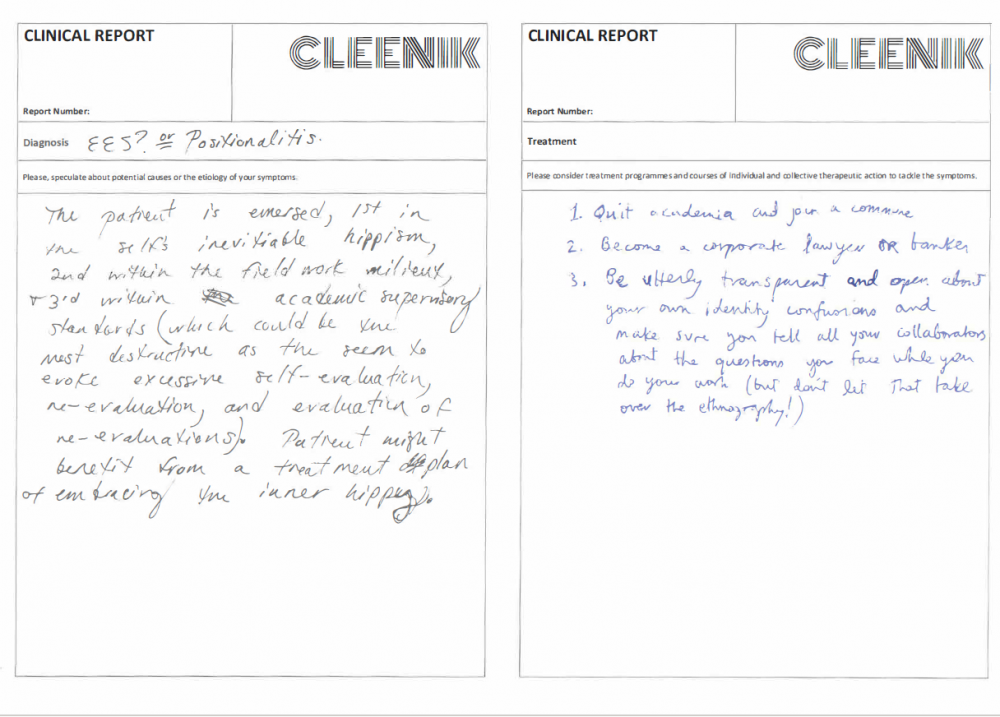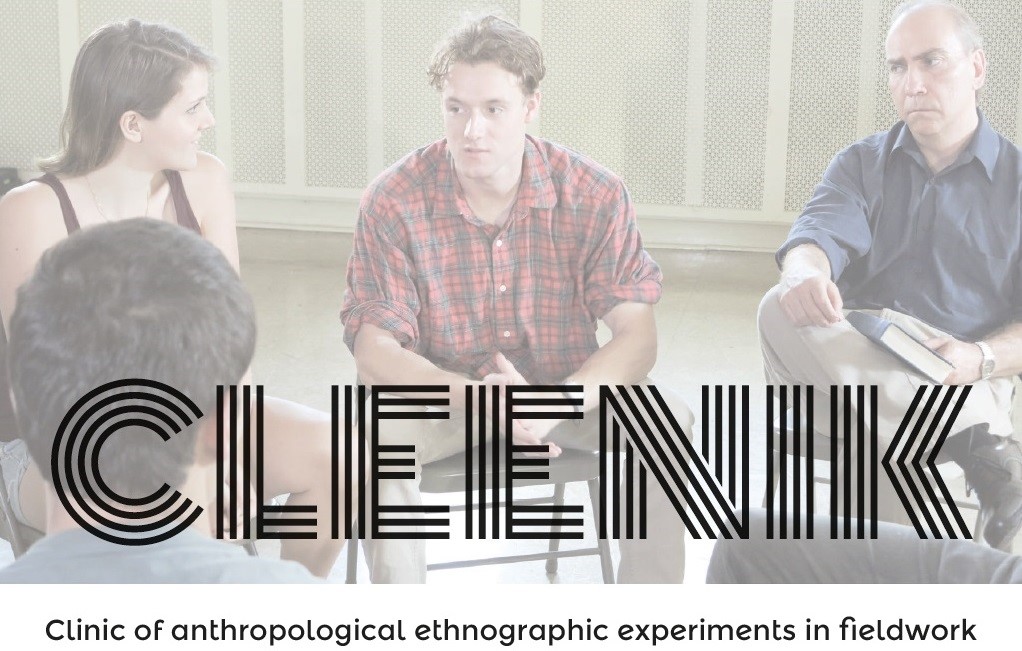The CLEENIK is a meeting methodology, a format that seeks to devise spaces to share and learn how to practice forms of ethnographic experimentation in fieldwork. Drawing on practices of care it aims at unfolding the conditions to tame the anxieties and uncertainties provoked by these particular ethnographic modalities we call ethnographic experimentation. It is addressed to anthropologist and ethnographers and it is especially apt for researchers in the early stage of their careers. It requires 1-2 hours and a small group of participants (around 10-15), for larger groups it is recommended to split in smaller units.
An anthropologist suffering from Excess of Engagement Stress (EES) when things between you and your natives get ‘too involved’, another experiencing a DDID Dissociative Disciplinary Identity Disorder and another one with positionalitis. These are just some of the symptoms and diagnosis collected in the second operation of the Clinic of Anthropological Ethnographic Experiments in Fieldwork. The CLEENIK, for short, is a especially designed format to treat anthropologists suffering from the multiple syndromes consequence of ethnographic experimentation during fieldwork. It is what we call an apprenticeship format for fieldwork learning, a pedagogical methodology especially designed to host, share and debate those ethnographic investigations carried out by anthropologists (and more generally ethnographers) that feels they are transgressing the assumed conventions of the ethnographic method. It is addressed to researchers that experience anxiety, uncertainty and doubts about what they may consider an appropriate practice of the ethnographic method. The CLEENIK aims at offering a protected space to those vulnerable investigators and open a space to share the uncertainties and apprehensions of their ethnographic projects.
It seeks to devise a different format of getting together, opening a space for care and complicity. Drawing inspiration on the common practices of self-help groups, the CLEENIK proposes a therapeutic space to take care of the anxiety so common in certain ethnographic projects (especially among young researchers). The therapeutic rhetoric is a playful parodic gesture that seeks to highlight the relevance of caring practices in all these encounters where we share knowledge.
Experimental collaborations
The CLEENIK comes of an investigation over the forms of ethnographic experimentation in fieldwork, a project that builds on our own ethnographic experience and those of others that have felt that their research cannot be appropriately described drawing on the most conventional tropes of fieldwork. We have experienced a form of engagement in our field that could not be described drawing on the traditional figure of participant observation. Our presence in the field shifted from the previously experienced modality of ‘participating in order to write’ (Emerson et al. 2005: 26) to a more engaged and interventionist practice. The experimental condition we appreciate in these ethnographies resonates and expands in new ways recent reflections contending the need to readdress fieldwork and reformulate its practice (Faubion and Marcus, 2009; Fabian, 2014). We echo debates on the place of ethnography in the production of anthropological knowledge (Ingold, 2008) and the transformation of the norm and form of fieldwork in a series of projects that have injected an experimental drive (Rabinow et al. 2008) and the need to ‘re-function ethnography’ (Holmes and Marcus, 2005).
Anxieties
This modality of ethnographic experimentation is accompanied by an intense experience that investigators are transgressing the norm and form of ethnography. Whether this is the case, or not, is not the point for the CLEENIK. The issue at stake is the associated anxiety and uncertainty that is especially acute and relevant for researchers in the early stages of their career. An experience that is not exceptional, since we have discovered similar fieldwork instances in other researchers during the early stages of their careers, as Isaac Marrero-Guillamón describes in his account of an ethnography among activist artists in London: “I had wanted to follow some artists’ work, but I was invited to become a collaborator; I had imagined that fieldwork would be based on some kind of distance with the objects and subjects of study, but I instead participated in the production of the very things I was studying; I failed to keep up with essentials such as field notes, and I wrote for the projects I wanted to study more often than about them” (2018: 183).The CLEENIK seeks to devise apprenticeship spaces for these ethnographic modalities and, at the same time, unfold the conditions to tame the anxieties and uncertainties provoked by this particular form of doing fieldwork.
Care and clinic
The CLEENIK is an adaptation of a previous format called Klinika, a methodology that we learnt from a collective called ColaBoraBora, a cultural and artistic association. The figure of the clinic tries to invoke the notion of care as a key practice. Theoretically it draws on Maria Puig de la Bellacasa (2017) discussion of an ethics of care that speculates with forms of living together, paying attention to the obligation not to just be concerned but “to take care of the fragile gathering things constitute” (Puig de la Bellacasa 2017: 45). It finds resonances on the artistic project of Natalie Jeremijenko of an Environmental Health Clinic, a project modelled after the notion of health clinics that “approaches health from an understanding of its dependence on external local environments; rather than on the internal biology and genetic predispositions of an individual”.
References
Emerson, R. M., Fretz, R. I., & Shaw, L. L. (1995). Writing Ethnographic Fieldnotes. Chicago: Chicago University Press.
Fabian, J. (2014). Time and The Other: How Anthropology Makes its Object. New York: Columbia University Press.
Faubion, J. D., & Marcus, G. E. (Eds.). (2009). Fieldwork Is Not What It Used to Be: Learning Anthropology’s Method in a Time of Transition. Ithaca, NY: Cornell University Press.
Holmes, D. R., & Marcus, G. E. (2005). Cultures of Expertise and the Management of Globalization: Toward the Re-Functioning of Ethnography. In A. Ong & S. J. Collier (Eds.), Global Assemblages: Technology, Politics, and Ethics as Anthropological Problems (pp. 235—252). Oxford: Blackwell.
Ingold, T. (2008). Anthropology is Not Ethnography. Proceedings of the British Academy, 154, 69—92.
Marrero-Guillamón, I. 2018. ‘Repurposing Ethnography as a Hosting Platform in Hackney Wick, London’. In Experimental collaborations. Ethnography through Fieldwork Devices, edited by A. Estalella and T. Sanchez Criado. New York: Berghahn.
Puig de la Bellacasa, M. 2017. Matters of Care. Speculative Ethics in More Than Human Worlds. Minneapolis: University of Minnesota Press.
Instructions – CLEENIK
Methodology
The format is organized in two parts. In the first parts the public is split in groups of 4-5 participants, they have to use a file card that is hand out, in the second part participants get together again and share the work they have produced. In the first section each participant is given the CLEENIK Clinical Report, a small booklet with three different sections, each one should be filled by a different participant.
In the first section of the clinical report each participant will have to describe his/her symptomatology: stating in a free but straightforward and thorough manner the nature of her/his problems in or after fieldwork. When finishing this first section, the clinical report will be hand out to the person sitting next, each participant will have to read the symptomatology of another participant and produce a diagnosis, speculating about the potential causes or the ethology of these symptoms.
When finishing this second part, the same clinical report will be passed out to a third participant, this one will have to read both the symptomatology and the diagnosis and based on both he/she will have to proposed a treatment, inviting to consider programmes and courses of individual and collective therapeutic action to tackle the symptoms.
Duration
The format requires at least 1 and 1.5 hours. Approximately 10 minutes should be dedicated to each of the three sections of the clinical report, and another 20-30 minutes should be dedicated to share in common the different symptoms and diagnosis when the first part of the format has been completed. Optionally, it is possible sometimes to open a third section: a final reflexive discussion on the format itself (10-20 minutes).
Participants
CLEENIK is appropriate for anthropologist in any stage of their career although it has been originally designed for early stage career scholars. In any case, it is designed for anthropologist with fieldwork experience, otherwise it would be difficult for them to participate. The operation of the CLEENIK requires intimacy and a limited number of participants, probably no more than 15.
Resources
Cornerstone in our experience in the CLEENIK format is the clinical report. It structures very easily the activity in three differentiate phases where everybody knows what to do. The second crucial aspect is that it draws on the common practice among anthropologist of writing. There is a model for the clinical report that may be modified, it may be found here.
Learning to get together. An ethnographic account of the CLEENIK
The CLEENIK is the outcome of collaborations with a Spanish cultural collective called Colaborabora. We invited them to help us organize a workshop dedicated to our sustained reflection about forms of ethnographic experimentation in the field in 2015. Under the name of ‘Investigations to the limit: A curatorship of experimental collaborations’ we gathered half a dozen young scholars from different disciplines (singularly, none of them was anthropologist) attended the event. They were working beyond the boundaries of their own disciplines and methods: an architect doing a ethnography of The Barley Field (the urban void we have mentioned before), an art historian doing an ethnographic inspired research of visual representations in Equatorial Guinea… Bringing ethnographic methods and diverse theoretical traditions to their own disciplines, they acknowledged their methodological anxieties and disciplinary troubles during a series of presentations that certainly echoed the title of the meeting.
We were making an explicit invocation in the title to the fertile exchanges between art and social sciences since the venue for our meeting was indeed the cultural institution Intermediae, an art centre (connected to Medialab-Prado) devote to experiment with visual aesthetics and participatory art . Our curatorial gesture (and the reference to the cures a curator may provide) had nevertheless a second reading key for our goal: we were pointing to those forms of investigations that are in precarious conditions for crossing conventional disciplinary boundaries, peripheral investigations located beyond the orthodoxy and were in need of care.
Colaborabora followed the line of the argument and proposed a format that took seriously the care invoked in the workshop: They organized a clinic for those needed researchers. Klinika, as they called it, was “an accompaniment service for the diagnosis and shared care aimed at developing healthy collaborative research projects. It is especially appropriate for experimental projects that leaving the orthodoxy and transgressing the canons provoke in researchers tensions, anxieties, dizziness, and great doses of vulnerability and uncertainty”. As in previous occasions, they offer us a rigid methodological proposal organized around a file card that imitated a medical report. The file invited participants to provide a diagnosis of symptoms and propose an appropriate treatment for the needed investigations.
The careful gesture of the workshop was extended to the documentation practice produced by an artist and researcher (and common friend) that we invited, Carla Boserman. She had been exploring in previous years forms of graphic documentation called relatogramas: “non-linear narratives that invoke a granulated and more peripheral gaze, a kind of graphic report, a device for listening, affection, and action”. She embodied with her work another instantiation of the diverse experiments with languages, aesthetics and formats for documentation that we have found during our fieldwork.
Care was an extended discourse at that time in our field. The assemblies in the open air turned the trope of what they called “active listening” (escucha activa) into a careful listening practice, workshops at Medialab-Prado always invoked the figure of hospitality as fundamental for these production events full of strangers, while many projects thriving in urban voids (like the Barley Field) described their engagement as forms of civic curatorship (of the city) or modes of urban stewardship. It resonates with Maria Puig de la Bellacasa (2017) discussion of an ethics of care that speculates with forms of living together, paying attention to the obligation not to just be concerned but “to take care of the fragile gathering things constitute” (Puig de la Bellacasa 2017: 45). Care certainly always required constant preoccupations with spaces, materialities, and techniques aimed at conditioning spaces to be together. It was a particular method unfolded in the many occasions in which our counterparts in the field came together to explore what was possible to do with others in the city—this was indeed the motive behind Colaborabora’s name: the exploration of forms of collaboration—. People operating under precarious economic conditions experimented with all kind of forms of collaboration. We discovered in these meetings the epistemic qualities of care: A precise method that designed ambiences of care that required to constantly taking care of them, spaces where our counterparts in the field problematized the precarious conditions of living during the crisis, driven by a collective effort of joint problem making (Sánchez Criado & Rodríguez-Giralt, 2017).
A year later we were bringing these peripheral methods we have learned from Colaborabora to the interior of our own discipline at the EASA Conference held in 2016 in Milano. We (Tomás Sánchez Criado and Adolfo Estalella) organized there another Klinika in collaboration with our colleague Andrea Gaspar. It was the first instantiation of the format that we have called CLEENIK: A clinic offered for anthropologists doing ethnographic experimentation in their fieldwork. We were not the only one in this move: Carla was attending the event and making her beautiful relatogramas of some of the key lectures (it was not our invitation). The CLEENIK reproduced the therapeutic practice of care so common in self-help groups. It was an attempt to bring the sensibility we had learned in our fieldwork into our own discipline, the invocation of the therapeutic rhetoric of a clinic was a playful parodic gesture that implicitly highlighted the relevance of care for the spaces of our encounters (something we had learn from our counterparts) and the need some investigations had to be treated with care. Months later, our colleague Eeva Berglun used the format in Finland and we used it again in the first workshop we organized as part of the Colleex EASA network (Collaboratory for Ethnographic Experimentation) in Lisbon.
The CLEENIK certainly mimics our fieldwork encounter and remediates it and brings inside our own discipline the apprenticeships we have made in our fieldwork: the therapeutic practices of care needed to think and make together. The Cleenik is a demonstrative example that comes of the tensions we faced between the norm and form of fieldwork we have learnt and the particular field encounters we had in our ethnographic investigations. This is a singular situation since our field was paradoxically challenging our methods and providing the methods to treat them. It is devised to tame the anxieties, difficulties and uncertainties of anthropologists that overflow methodological boundaries, experiencing a disparity between the canonical method and their fieldwork experience. It is a modest attempt to devise appropriate apprenticeship venues for contemporary conditions for ethnography.
Download the CLEENIK clinical report: DOC format & PDF format.
If you’d like to set up your own CLEENIK, please do copy the model, it’s open source!
Download the postcard flyer and spread the word!
Postcard design and logo: Anna Gonchar | Image credits CC BY Lwp Kommunikáció
**
CLEENIK is an open-source adaptation and a continuation for ethnographic audiences of ColaBoraBora’s Klinika also an adaptation of an initiative by Maria Salazar, part of her artistic residence at Muelle3 in Bilbao.


